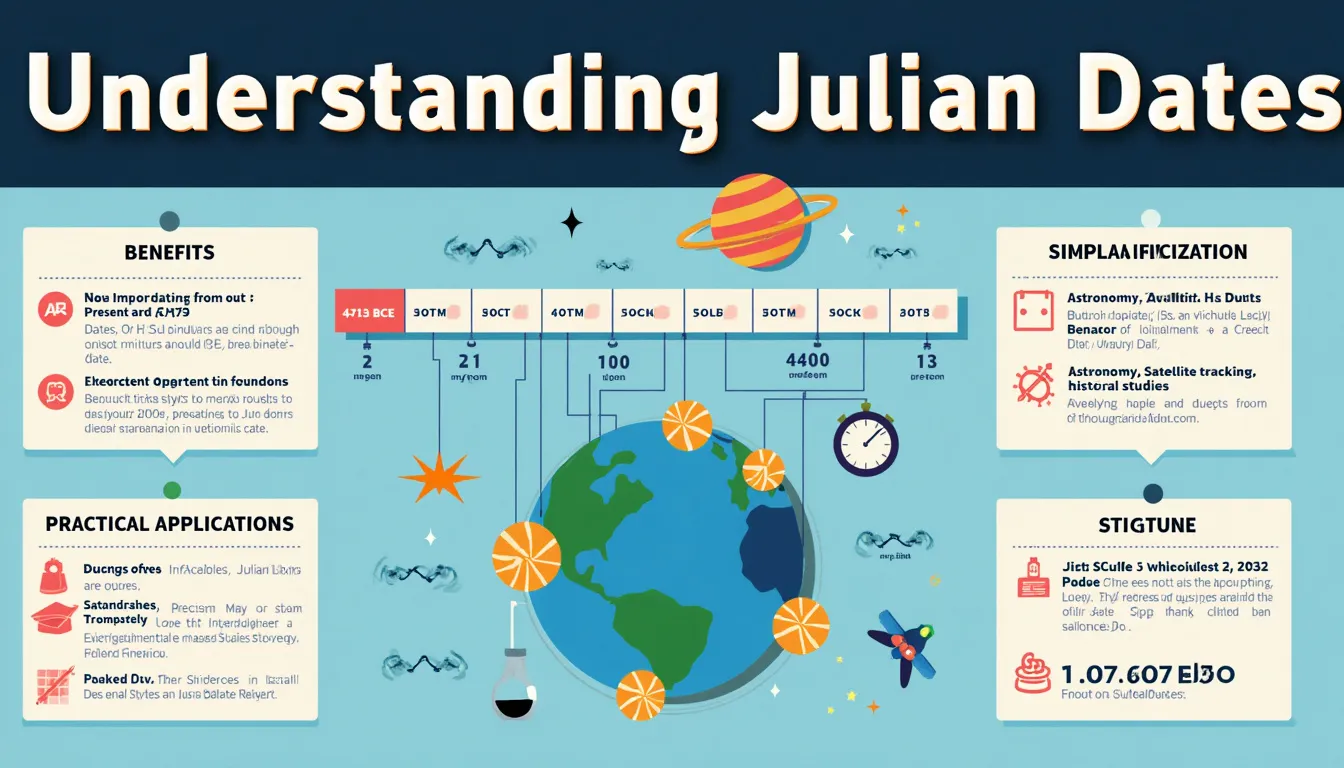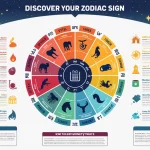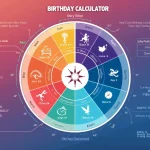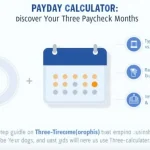Julian Date Calculator
Is this tool helpful?
How to Use the Julian Date Calculator Effectively
Our Julian Date Calculator is designed to convert Gregorian calendar dates into precise Julian Dates, a system essential in astronomy and scientific research. Follow these steps for accurate calculations:
1. Enter the Gregorian Date
- Year: Type the year as a whole number, such as 1995 or 2027. The calculator supports years ranging from -4713 to 9999.
- Month: Select the month from the dropdown, for example, April (4) or November (11).
- Day: Enter the day number, such as 23 or 7, matching the selected month.
2. Specify the Time (Optional)
- Hour: Insert the hour in 24-hour format, e.g., 9 for 9 AM or 21 for 9 PM.
- Minute: Input the minutes value, such as 45 or 10.
- Second: Provide seconds, for example, 30 or 0.
3. Set the Time Zone Offset (Optional)
Specify your time zone offset from Coordinated Universal Time (UTC) in hours. Use positive numbers for time zones ahead of UTC and negative for those behind. Examples include:
- Paris (CET): +1
- Moscow (MSK): +3
- Los Angeles (PST): -8
4. Calculate the Julian Date
After entering your details, click the “Calculate Julian Date” button. The calculator will display the Julian Date (JD) along with the Modified Julian Date (MJD).
5. Understand the Results
The results include:
- Julian Date (JD): The continuous count of days and fractions since noon on January 1, 4713 BCE.
- Modified Julian Date (MJD): A simplified form calculated as JD – 2400000.5, often used for easier date management.
Introduction to the Julian Date Calculator: Purpose and Benefits
The Julian Date Calculator transforms Gregorian calendar dates into Julian Dates, a vital timekeeping system used in astronomy, satellite tracking, and various scientific applications. By using this calculator, users can achieve:
- Accurate time tracking for celestial events and scientific observations
- Standardized date conversions compatible with historical and astronomical data
- Easier calculation of time intervals across long periods and multiple calendar systems
- Support for historical research through precise date correlation across eras
Julian Dates serve as a continuous time scale from a fixed point in history, simplifying complex date arithmetic and providing a consistent framework for scientific and historical analyses.
Example Calculations Using the Julian Date Calculator
Example 1: Calculating the Julian Date for a Solar Eclipse Observation
Suppose an astronomer records a solar eclipse on September 10, 2021, at 16:35 UTC, in the time zone offset of +0.
- Year: 2021
- Month: 9 (September)
- Day: 10
- Hour: 16
- Minute: 35
- Second: 0
- Time Zone Offset: 0
Using the calculator, the Julian Date is approximately 2459470.18958, with the Modified Julian Date as 59469.68958.
Example 2: Tracking a Satellite Pass Over Tokyo on December 5, 2024, 03:20 JST
- Year: 2024
- Month: 12 (December)
- Day: 5
- Hour: 3
- Minute: 20
- Second: 0
- Time Zone Offset: +9 (JST)
The Julian Date result is approximately 2460315.63889, and the Modified Julian Date is 60315.13889, enabling precise scheduling for satellite communication.
The Science Behind Julian Date Calculation
The Julian Date (JD) counts days continuously from noon on January 1, 4713 BCE, serving as a foundation for astronomical and scientific timing. The calculator employs this formula:
$$ JD = \text{floor}(365.25 \times (Y + 4716)) + \text{floor}(30.6001 \times (M + 1)) + D + B – 1524.5 + \frac{UT}{24} $$Where:
- Y = year (adjusted if month is January or February)
- M = month (with January and February counted as months 13 and 14 of the previous year)
- D = day of the month
- B = Gregorian calendar correction factor
- UT = Universal Time in decimal hours (hour + minute/60 + second/3600) minus time zone offset
This formula accounts for leap years and calendar adjustments to provide a continuous count of days and fractional days, making it indispensable for scientific timekeeping and data coordination.
Benefits of Using the Julian Date Calculator for Accurate Time Measurement
Precision in Scientific and Astronomical Research
Julian Dates allow astronomers to calculate the exact timing of celestial events, track satellite orbits, and forecast astronomical phenomena with high precision.
Simplification of Complex Date Calculations
By converting calendar dates to a continuous day count, the Julian Date system facilitates simple subtraction to find time intervals, bypassing complications from leap years and calendar changes.
Universal Standardization Across Scientific Fields
Julian Dates serve as a universal timekeeping standard in astrophysics, satellite communications, geophysics, and historical research, ensuring consistency and reducing ambiguity.
Historical Correlation and Analysis
Historians and archaeologists use Julian Dates to correlate events across different calendar systems accurately, aiding precise dating of artifacts and ancient observations.
Important Disclaimer
The calculations, results, and content provided by our tools are not guaranteed to be accurate, complete, or reliable. Users are responsible for verifying and interpreting the results. Our content and tools may contain errors, biases, or inconsistencies. Do not enter personal data, sensitive information, or personally identifiable information in our web forms or tools. Such data entry violates our terms of service and may result in unauthorized disclosure to third parties. We reserve the right to save inputs and outputs from our tools for the purposes of error debugging, bias identification, and performance improvement. External companies providing AI models used in our tools may also save and process data in accordance with their own policies. By using our tools, you consent to this data collection and processing. We reserve the right to limit the usage of our tools based on current usability factors.







